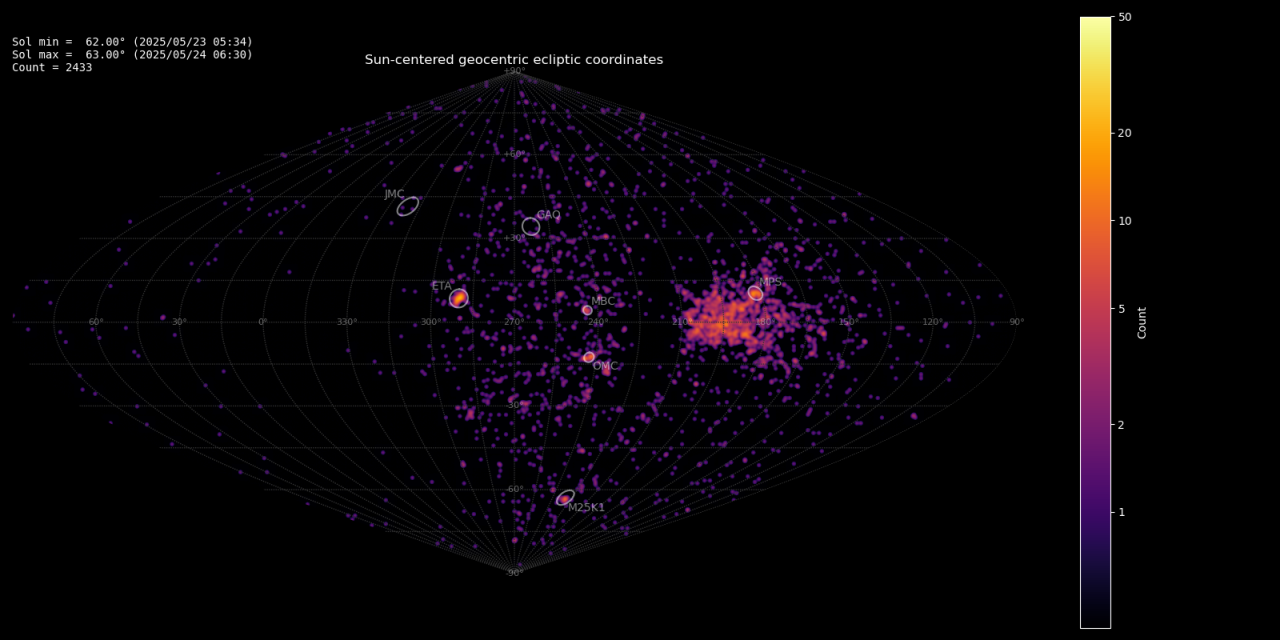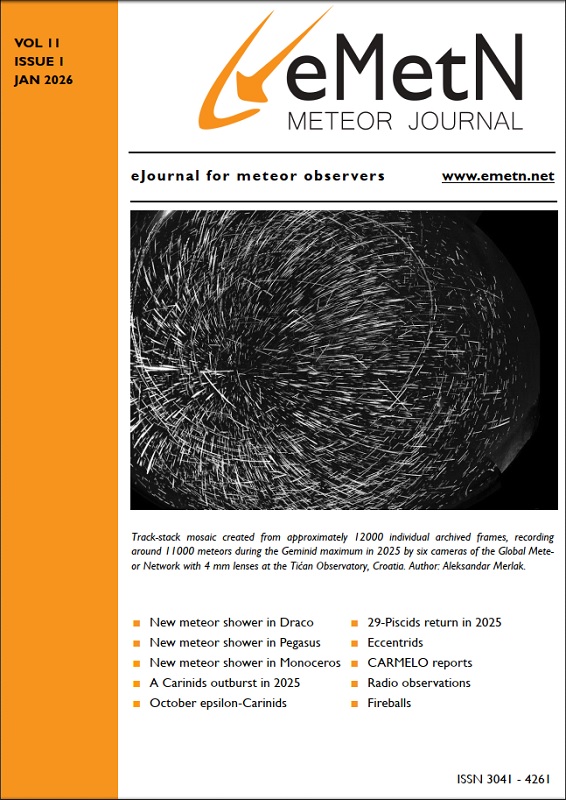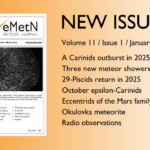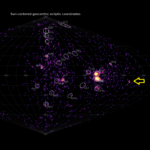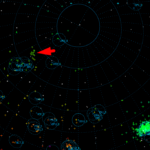By Denis Vida, Damir Šegon and Paul Roggemans
Abstract: A new meteor shower on a Halley-type comet orbit (TJ = 0.93) has been detected during May 22–24, 2025 by the Global Meteor Network. Meteors belonging to the new shower were observed between 61° < λʘ < 63.5° from a radiant at R.A. = 349° and Decl.= –80° in the constellation of Octans, with a geocentric velocity of 40.6 km/s. The new meteor shower has been listed in the Working List of Meteor Showers under the temporary name-designation: M2025-K1.
Introduction
The GMN radiant map for 23–24 May 2025 shows a concentration of radiants in the constellation of Octans (Figure 1). Nineteen meteors were observed by the Global Meteor Network low-light video cameras during 2025 May 22–24. The shower was independently observed by cameras in three countries in the southern hemisphere (Australia, New Zealand, and South Africa).
The shower had a median geocentric radiant with coordinates R.A. = 349.06°, Decl. = –79.83°, within a circle with a standard deviation of ± 1.05 deg (equinox J2000.0). The radiant drift in R.A. is 4.7° on the sky per degree of solar longitude and 0.9° in Decl., both referenced to solar longitude 62.3°. The median geocentric, Sun-centered ecliptic longitude (λ–λʘ) being 229.94°, and geocentric ecliptic latitude –62.86°. The geocentric velocity was 40.6 ± 0.3 km/s.
The new meteor shower has been reported to the IAU-MDC and added in the Working List of Meteor Showers under the temporary name-designation: M2025-K1 (Vida and Šegon, 2025).
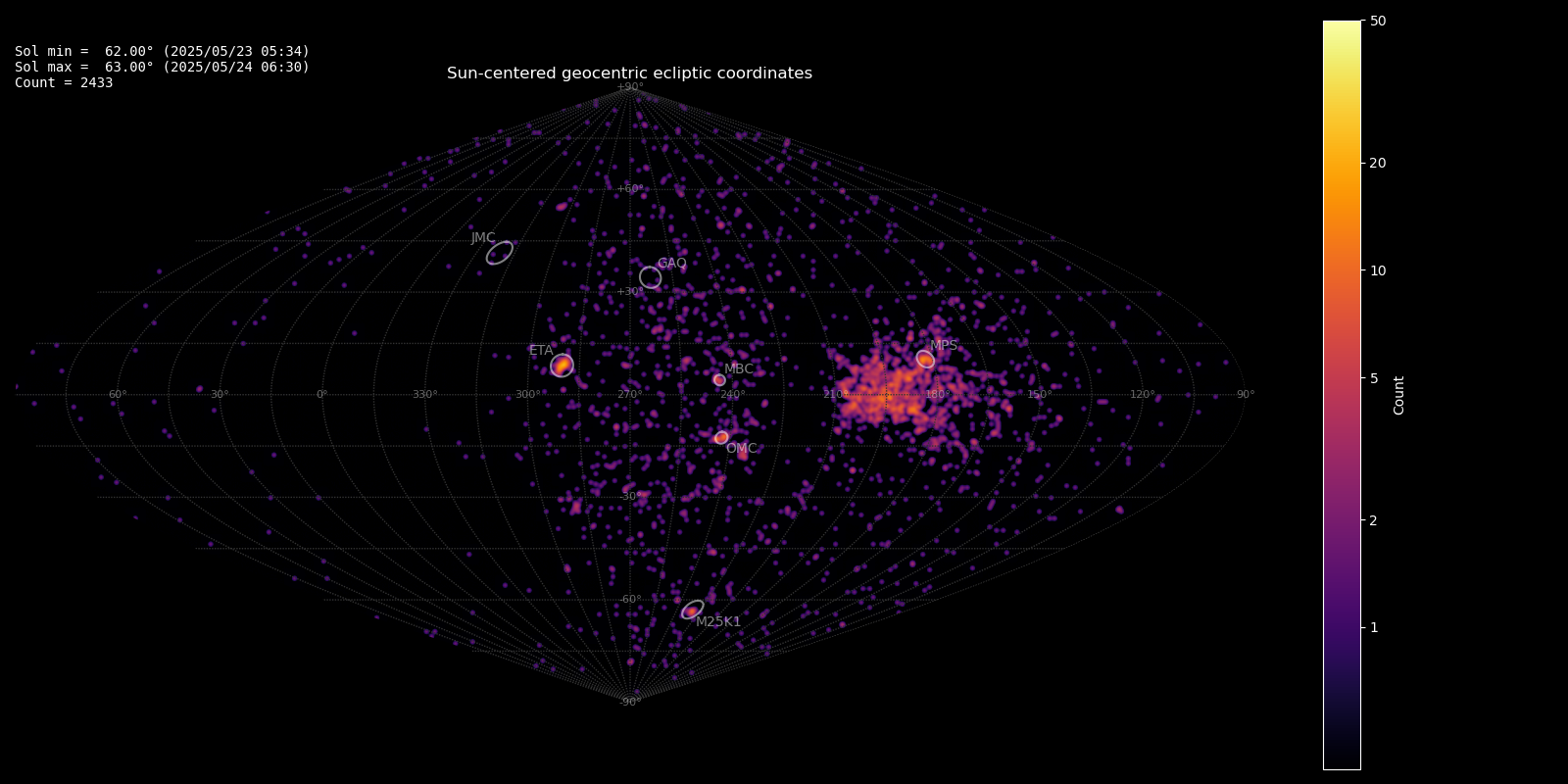
Figure 1 – Heat map with 2433 radiants obtained by the Global Meteor network on 23–24 May 2025. A compact concentration is visible in Sun-centered geocentric ecliptic coordinates which was identified as a new meteor shower with the temporary identification M2025-K1.
First identification
The Railey distribution fit pointed at a DD value of 0.09 as the orbital similarity cutoff (Figure 2), which resulted in 150 orbits representing the possibly new meteor shower.
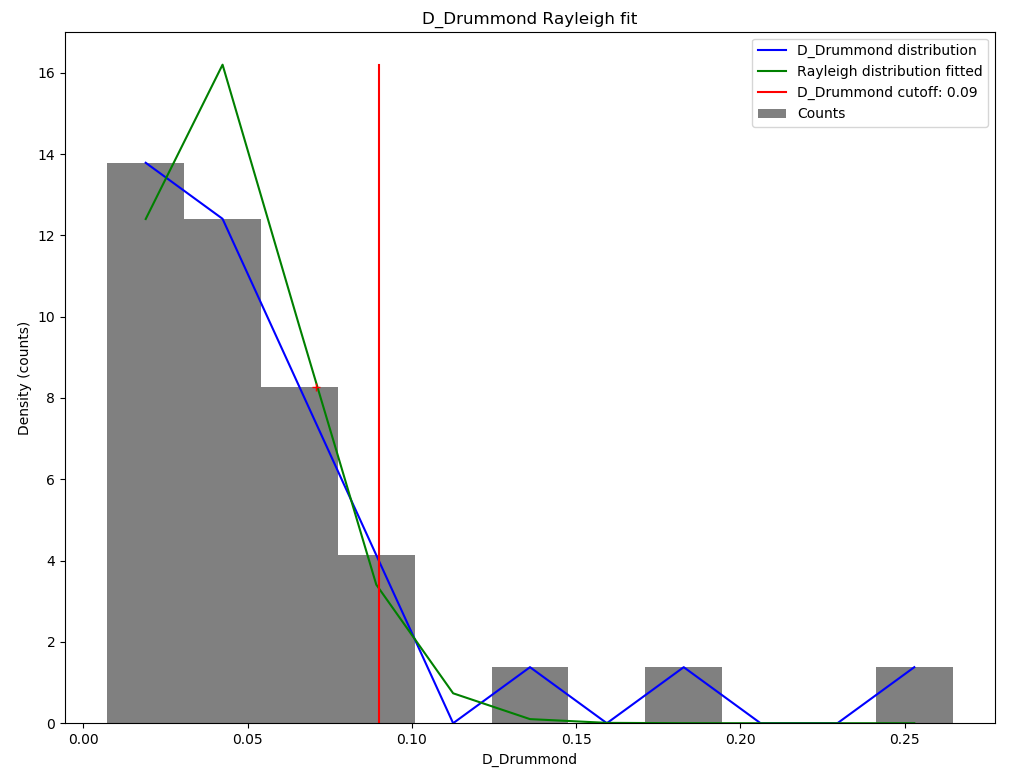
Figure 2 – Rayleigh distribution fit and Drummond DD criterion cutoff.
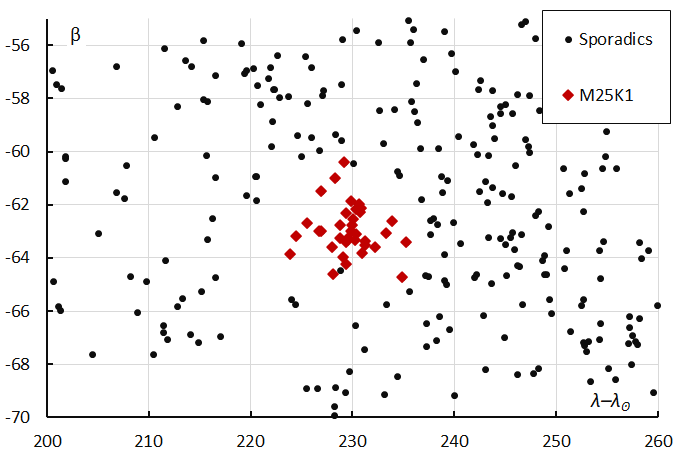
Figure 3 – The radiant in geocentric Sun-centered ecliptical coordinates for the 35 orbits identified as M2025-K1.
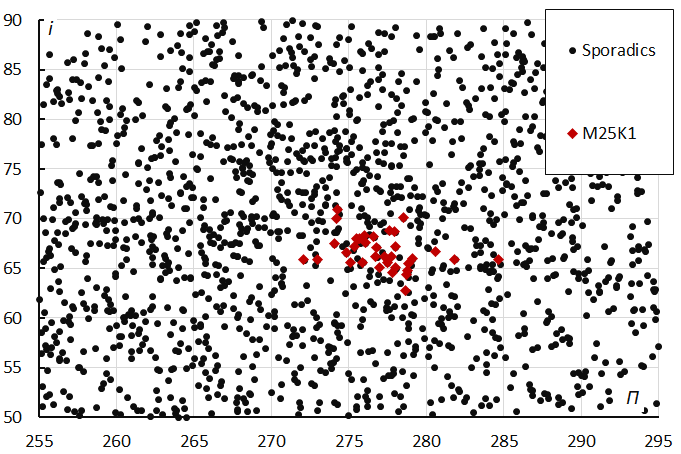
Figure 4 – The diagram of the inclination i against longitude of perihelion Π shows a distinct group of radiants identified as M2025-K1.
The GMN shower association criterion assumes that meteors within 1° in solar longitude, within 3° in radiant, and within 10% in geocentric velocity of a shower reference location are members of that shower. Further details about the shower association are explained in Moorhead et al. (2020). This is a rather strict criterion since meteor showers often have a larger dispersion in radiant position, velocity and activity period. Using these meteor shower selection criteria, 35 orbits have been associated with the new shower in the GMN meteor orbit database (Figure 3). Also, the diagram of the inclination i against longitude of perihelion Π shows a distinct group of radiants identified as M2025-K1 (Figure 4).
Another search method
Another method has been applied to check this new meteor shower discovery. The starting point here can be any visually spotted concentration of radiant points or any other indication for the occurrence of similar orbits. The method has been described before (Roggemans et al., 2019). The main difference with the method applied in Section 2 is that three different discrimination criteria are combined in order to have only those orbits which fit different criteria. The D-criteria that we use are these of Southworth and Hawkins (1963), Drummond (1981) and Jopek (1993) combined. Instead of using a cutoff value for the D-criteria these values are considered in different classes with different thresholds of similarity. Depending on the dispersion and the type of orbits, the most appropriate threshold of similarity is selected to locate the best fitting mean orbit as the result of an iterative procedure.
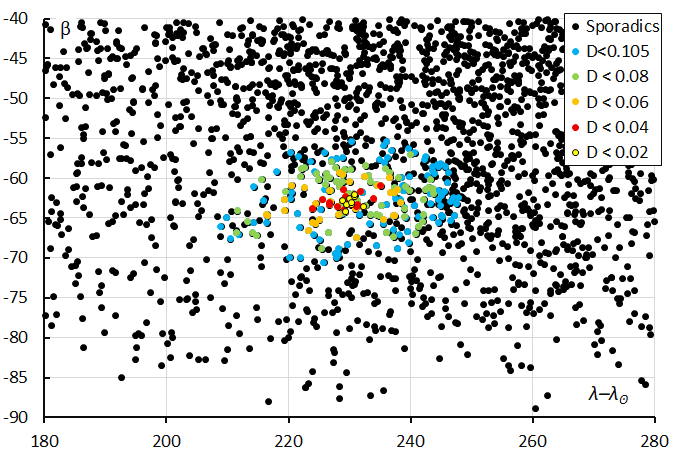
Figure 5 – The radiant in geocentric Sun-centered ecliptical coordinates for different classes of D criterion threshold.
To avoid contamination with sporadics the search interval was limited to 50° < λʘ < 75°. The Global Meteor Network had 48411 meteor orbits within this interval. After some iterations the procedure converged on a mean orbit computed following the method of Jopek et al. (2006) with 120 orbits that fit the D-criteria with DD < 0.08. The result is shown in Figure 5. Compared to the first method, the selection based on D criteria results in significant more candidates recorded during a longer activity period and much more dispersed radiant distribution.
The dispersion maybe affected by contamination with sporadic particle orbits. The Railey distribution fit as the orbital similarity cutoff with DD value of 0.09 looks too optimistic. Decreasing the DD value in steps of 0.01 shows a concentration comparable to the first method for DD = 0.05. The orbits are compared in Table 1.
Comparing the results of the two method
Both methods confirm the presence of a new so far unknown minor meteor shower, but there are some differences (see Table 1) and it is interesting to visualize these differences. In Figure 6 the radiant distribution for both methods is shown in a single graph.
Table 1 – Comparing the new meteor shower, derived by two different methods, M2025-K1 the orbital parameters as initially derived, DD < 0.08 and DD < 0.05 were derived from the method described in Section 3.
| M2025-K1 | DD < 0.08 | DD < 0.05 | |
| λʘ (°) | 62.3 | 62.29 | 62.1 |
| λʘb (°) | 61.0 | 51.0 | 56.8 |
| λʘe (°) | 63.5 | 73.6 | 67.3 |
| αg (°) | 349.1 | 338.4 | 347.4 |
| δg (°) | –79.8 | –79.0 | –80.2 |
| Δαg (°) | –4.67 | – | – |
| Δδg (°) | –0.90 | – | – |
| vg (km/s) | 40.6 | 40.8 | 40.6 |
| λg (°) | 292.38 | 293.4 | 291.7 |
| λg – λʘ (°) | 230.08 | 229.9 | 229.4 |
| βg (°) | –62.83 | –62.6 | –63.0 |
| a (A.U.) | 11.2 | 10.0 | 11.6 |
| q (A.U.) | 0.927 | 0.919 | 0.922 |
| e | 0.917 | 0.908 | 0.920 |
| i (°) | 66.6 | 67.4 | 66.6 |
| ω (°) | 34.4 | 34.5 | 34.8 |
| Ω (°) | 242.2 | 242.7 | 241.7 |
| Π (°) | 276.6 | 277.1 | 276.5 |
| Tj | 0.93 | 0.97 | 0.91 |
| N | 19 | 120 | 36 |
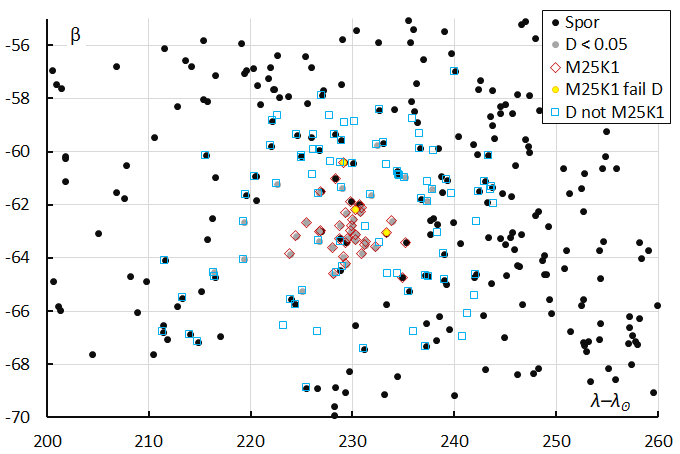
Figure 6 – Comparing the radiant in geocentric Sun-centered ecliptical coordinates obtained by two different methods.
Comparing the radiants associated according to the two methods we see that:
- The 36 grey dots with DD< 0.05 have the best overlap with the red open diamonds that represent the 35 radiants that were identified by the first method. Note that several grey dots were not identified as M2025-K1 by the first method, while several red diamonds did not match DD < 0.05, three of them don’t even fulfill DD < 0.105 (yellow circles).
- The 88 blue squares mark radiants that fulfill DD< 0.08 and which were not identified as M2025-K1 in the GMN orbit dataset. The sporadic radiants (black dots) are plotted for the time interval 55° < λʘ < 65°. The open blue squares are orbits with DD < 0.08 detected before λʘ = 55° or after λʘ = 65°.
Figure 7 shows the distribution of the orbits with the inclination i against longitude of perihelion Π for the orbits identified as M2025-K1 by the first method, the result of the second method based on D-criteria and differences between both methods as explained above for Figure 6.

Figure 7 – The diagram of the inclination i against the longitude of perihelion Π for different classes of D criterion threshold and the differences between both meteor shower identification methods.
Orbit and parent body
The Tisserand’s parameter Tj identifies the orbit as of a Halley-type comet. A parent-body search returned no candidates with a Southworth and Hawkings D criterion value lower than 0.35. The new shower received the working designation M2025-K1 from the IAU Meteor Data Center.
The mean orbit obtained for the initial 19 orbits on which the discovery was based agrees very well with the mean orbit based on the D-criteria for 36 orbits with DD < 0.05. Even the mean orbit for 120 events with DD < 0.08 compares very well, even though this selection may include some sporadic contamination. We used a new tool to visualize meteor orbits, developed by Pető Zsolt to plot both mean orbits (Figure 8). With an aphelion beyond the orbit of planet Uranus, both plots are almost identical.
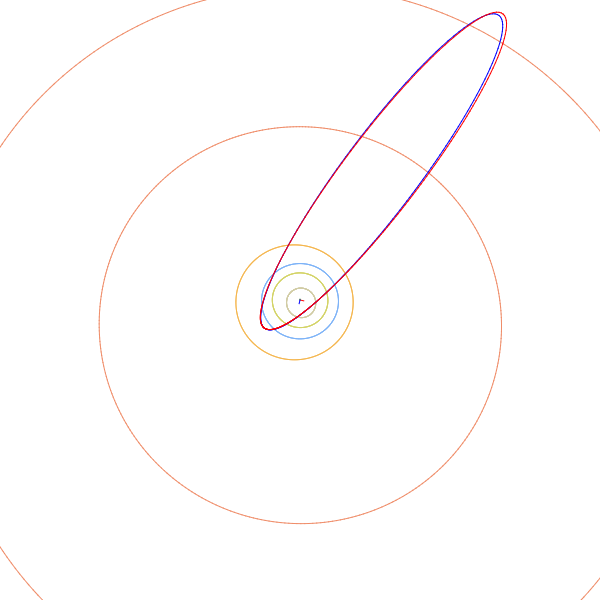
Figure 8 – Comparing the mean orbit based on the shower identification according to two methos, blue is for M2025-K1 and red for DD < 0.05 in Table 1. (Plotted with the Orbit visualization app provided by Pető Zsolt).
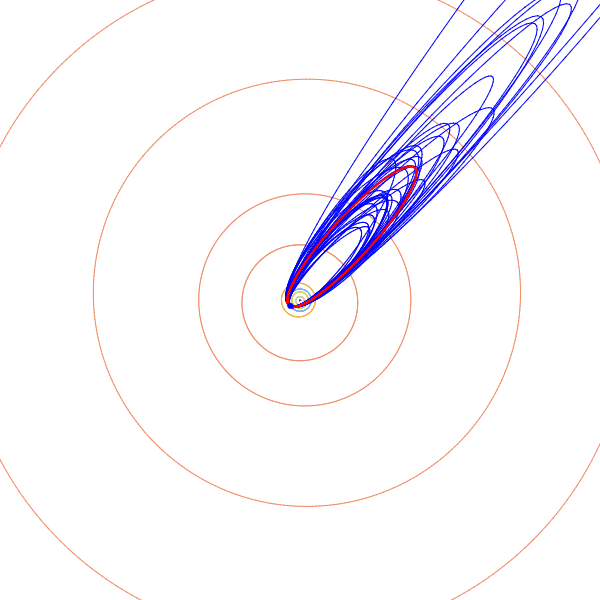
Figure 9 – All 36 orbits based on DD < 0.05 (blue) and their mean orbit (red). (Plotted with the Orbit visualization app provided by Pető Zsolt).
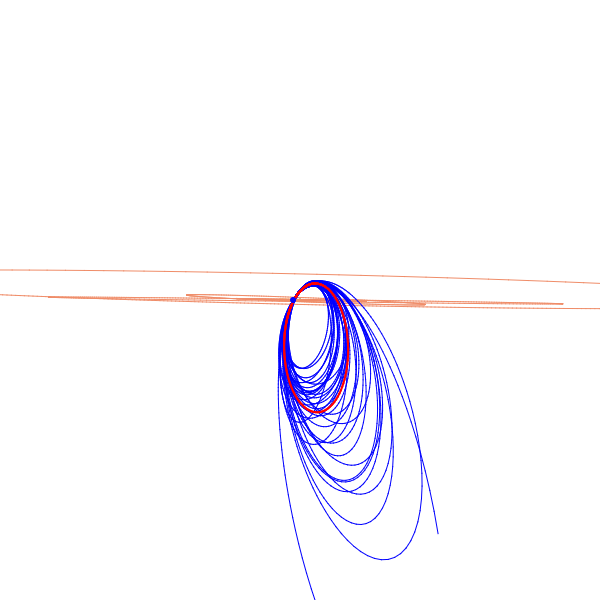
Figure 10 – All 36 orbits based on DD < 0.05 (blue) and their mean orbit (red) as seen in the ecliptic plane. (Plotted with the Orbit visualization app provided by Pető Zsolt).
Using a meteor trajectory in our atmosphere to obtain its orbit in the Solar System is very sensitive to measurement uncertainties of both the direction of the trajectory (radiant) and the velocity. The slightest uncertainty on the velocity has a huge effect on the eccentricity and aphelion. For this reason, GMN applies high quality validations. Not all combinations in meteor triangulations yield reliable orbits, therefore quality selection is very important.
We used the tool to visualize meteor orbits, developed by Pető Zsolt to plot all 36 orbits (blue) with DD < 0.05 in Figure 12 seen perpendicular on the ecliptic and seen in the ecliptic plane in Figure 13. The mean orbit is computed using the method of Jopek et al. (2006), the dispersion on the individual orbits (blue) can be visualized this way.
Activity in past years
A search in older GMN orbit data revealed five orbits that fit the DD < 0.08 criterion during the interval 61.1° < λʘ < 64.2°. 28 similar orbits were recorded in 2023, fourteen of these within the interval 60° < λʘ < 64°. In 2024 GMN had 36 orbits that fit the D criteria, only six of these in the time interval 60° < λʘ < 64°.
Conclusion
The discovery of a new meteor shower with a radiant in the constellation of Octans based on nineteen meteors during 2025 May 22–24 has been confirmed. Meanwhile 35 orbits were identified as M2025-K1 in the GMN meteor orbit dataset. The new shower has also been confirmed by an independent meteor shower search method based on D-criteria. The resulting mean orbits for both search methods are in good agreement. The activity period is longer than initially assumed and orbits of this meteor shower have been recorded in past years.
Acknowledgment
This report is based on the data of the Global Meteor Network (Vida et al., 2020a; 2020b; 2021) which is released under the CC BY 4.0 license. We thank all 825 participants in the Global Meteor Network project for their contribution and perseverance. A list with the names of the volunteers who contribute to GMN has been published in the 2024 annual report (Roggemans et al., 2025).
References
Drummond J. D. (1981). “A test of comet and meteor shower associations”. Icarus, 45, 545–553.
Jopek T. J. (1993). “Remarks on the meteor orbital similarity D-criterion”. Icarus, 106, 603–607.
Jopek T. J., Rudawska R. and Pretka-Ziomek H. (2006). “Calculation of the mean orbit of a meteoroid stream”. Monthly Notices of the Royal Astronomical Society, 371, 1367–1372.
Moorhead A. V., Clements T. D., Vida D. (2020). “Realistic gravitational focusing of meteoroid streams”. Monthly Notices of the Royal Astronomical Society, 494, 2982–2994.
Roggemans P., Johannink C. and Campbell-Burns P. (2019a). “October Ursae Majorids (OCU#333)”. eMetN Meteor Journal, 4, 55–64.
Roggemans P., Campbell-Burns P., Kalina M., McIntyre M., Scott J. M., Šegon D., Vida D. (2025). “Global Meteor Network report 2024”. eMetN Meteor Journal, 10, 67–101.
Southworth R. B. and Hawkins G. S. (1963). “Statistics of meteor streams”. Smithsonian Contributions to Astrophysics, 7, 261–285.
Vida D., Gural P., Brown P., Campbell-Brown M., Wiegert P. (2020a). “Estimating trajectories of meteors: an observational Monte Carlo approach – I. Theory”. Monthly Notices of the Royal Astronomical Society, 491, 2688–2705.
Vida D., Gural P., Brown P., Campbell-Brown M., Wiegert P. (2020b). “Estimating trajectories of meteors: an observational Monte Carlo approach – II. Results”. Monthly Notices of the Royal Astronomical Society, 491, 3996–4011.
Vida D., Šegon D., Gural P. S., Brown P. G., McIntyre M. J. M., Dijkema T. J., Pavletić L., Kukić P., Mazur M. J., Eschman P., Roggemans P., Merlak A., Zubrović D. (2021). “The Global Meteor Network – Methodology and first results”. Monthly Notices of the Royal Astronomical Society, 506, 5046–5074.
Vida D., Šegon D. (2025). “New meteor shower in Octans”. D.W.E. Green, editor, CBET 5559.

